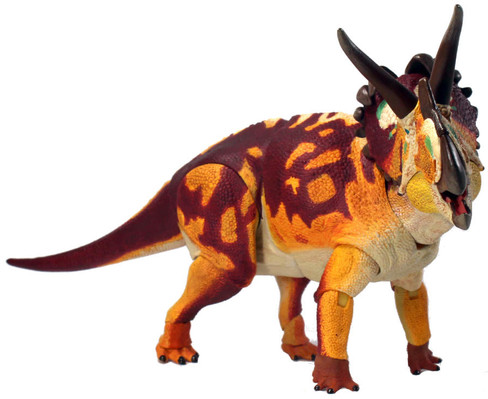Beasts of the Mesozoic Wendiceratops pinhornensis
Beasts of the Mesozoic Wendiceratops pinhornensis Manufacturer Information:
Wendiceratops pinhornensis- 1/18th scale Dinosaur Action Figure
One of the oldest known centrosaurines, Wendiceratops was first discovered in 2010 by Canadian fossil hunter Wendy Sloboda (whom the genus is named after). It's considered to be a sister species to Sinoceratops due to its similar frill ornamentation. This ceratopsian figure measures 12 in. long and has 20 points of articulation. Includes collectible trading card, unique background display insert and instruction sheet. Packaging features red-foil printing with package art by Raul Ramos.
Recommended for ages 15 and up.
Wendiceratops pinhornensis Information:
Wendiceratops pinhornensis is a species of dinosaur that belongs to the family Ceratopsidae, a group of herbivorous dinosaurs known for their elaborate frills and horns. The specific name "pinhornensis" refers to the location where the dinosaur was discovered, the Pinhorn Provincial Grazing Reserve in Alberta, Canada.
Here is some information about Wendiceratops pinhornensis:
Discovery: Wendiceratops was first described in 2015 in a research paper published in the journal PLOS ONE. The dinosaur is known from a nearly complete skull, as well as some postcranial (non-skull) remains.
Classification: Wendiceratops belongs to the larger group of ceratopsid dinosaurs, which includes well-known species like Triceratops. Its exact placement within the ceratopsid family tree is still a subject of ongoing research and discussion among paleontologists.
Physical Characteristics: Based on its fossil remains, Wendiceratops was a relatively small ceratopsid dinosaur, estimated to have been about 4-5 meters (13-16 feet) in length. It likely walked on all fours and had a beak-like mouth for feeding on vegetation.
Unique Features: One of the most notable features of Wendiceratops is the presence of two large, forward-curving, hook-like horns on its frill, which are quite distinct from the horns seen in other ceratopsid species. Additionally, it had a prominent bony frill at the back of its skull, which might have served as a display structure for species recognition or mate attraction.
Paleoenvironment: Wendiceratops lived during the Late Cretaceous period, approximately 79-77 million years ago. At that time, the area that is now Alberta, Canada, was a lush and diverse landscape with various dinosaurs, including other ceratopsids, hadrosaurs, and tyrannosaurs.
Scientific Significance: Wendiceratops is of great importance to paleontologists as it provides valuable insights into the diversity and evolution of ceratopsid dinosaurs during the Late Cretaceous. Its unique horn arrangement and frill characteristics have helped researchers better understand the complex evolutionary patterns within this group.
Hand Painted. Product Material: PVC
Product Code: #62084by Beasts of the Mesozoic




















